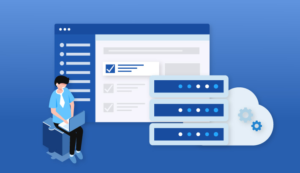A full-stack developer is a programmer who works on a website or application’s front and back ends. This work necessitates a great deal of industry knowledge and technical abilities, therefore it’s critical to demonstrate your qualifications to a potential employer during the interview process. Here are some generic full stack developer interview questions you can encounter.
Knowing more about popular full stack developer interview questions and viewing example replies might help you come up with your responses. We’ve compiled a list of 45 full-stack developer interview questions with sample answers to help you prepare for your next interview.
Using generic questions, a recruiting manager may discover more about your personality, qualities, and work ethic.
45+ Full Stack Developer Interview Questions
Let’s get started with the Full stack developer interview questions with answers.
Q1. What is your favorite programming language, and why is it your favorite?
The full-stack developer usually knows
- HTML & CSS
- Python
- JavaScript
- MEAN
As a Full Stack Developer, you should be able to not only grasp various computer languages but also select your favorite language that you know well and are comfortable with. As a result, you’ll be able to simply demonstrate when requested.
Q2. So, what was the most recent thing you discovered?
The interviewer is asking this question to learn all you know, and they will look into your CV’s authenticity. They’d also like to see what you’ve been up to in the last six months. You can describe the task or project to them and tell them about the bugs you encountered and how you fixed them. You can also describe what you learned from the websites you visited and analyze current trends. This will assist you and inform the interviewer about your activities during the last six months.
Q3. What technologies and programming languages will you need to complete a project from start to finish?
It’s a test of the interviewer’s ability to assess your willingness to begin working. This is a hotly debated topic. A full-stack developer who is skilled and proficient may easily be distinguished from one who is inexperienced. As a result, you must respond cautiously.
Q4. What is pair programming? Have you ever done it?
Pair programming is when two programmers work on the same terminal at the same time. The two programmers who will be involved in the programming must take into account the key features of extreme programming. Given your expertise with pair programming, you should respond as soon as possible.
Q5. What is CORS?
CORS stands for cross-origin resource sharing and enables the sharing of resources from a number of sources, as the name implies. CORS is a technology that enables multiple domains to access various web resources. CORS enables web scripts to link to external content on the originating domain more readily, allowing for improved integration across online services.
Domain1.com must perform a simple cross-origin request in order to access resources from domain2.com, which is finished. A photo, a CSS file, or anything else may be one of these resources. The browser’s built-in behavior blocks access to cross-origin HTTP requests, which has major security concerns.
Q6. Are you aware of design patterns?
When designing a web application, you should be aware of the common errors and difficulties that arise. You should use force to get the employer’s trust by explaining your coding expertise if you have a very high degree of proficiency.
Q7. What is multithreading?
For the full stack developer job profile, this question measures the candidate’s computer architecture skills. Multithreading is useful since it improves the CPU’s performance. The operating system helps by running a large number of threads or strategies.
Multithreading allows several users to manage a program or handle numerous requests from the same user at the same time. It is primarily performed by running a number of processes supported by the operating system.
Q8. What is Continuous Integration?
Continuous integration can automate device development, testing, and deployment. If a single person or a group is working on a software project, continuous integration should be used as a hub to ensure that important procedures such as unit testing are automated rather than arduous.
As a result, developers may be able to deploy code quickly during the development process. This is mostly used to assimilate principles several times during the day. The most significant advantage in the early detection and identification of flaws.
Q9. What are you coding currently?
A person who likes technology will constantly work with it, whether for business or pleasure.
You’ll stand out if you’re one of the programmers that codes for skill growth.
Q10. Explain inversion of control?
IoC (Inversion of Control) inverts the control flow, unlike regular control flow. In IoC, custom-written computer program components are given a general control flow. Traditional programming employs reused libraries to accomplish a general function instead of the unique code that reflects the program’s goal.
The frame is still where the custom or task-specific code is called in when using reverse control. The software architecture is the same, and it operates in the opposite way as traditional procedural programming.
Q11. What is long polling?
Long polling is a good approach to generate a very stable server connection without utilizing the WebSocket or Server Side Events protocols. This function is used in Node.js’s Next Development Model.
Long Polling, in other words, is a method of polling that operates on top of the usual client-server model. Because it includes new and unique data, the customer sends the request, and the server responds until the connection is formed.
When the server answers, a request can be sent to the client, and the server will return a query when data is available. When the client application is closed and the server has completed processing requests, it activates.
Q12. Give an example of a project and the technology you have been working on. How have you picked these?
This aids in determining a candidate’s approach and efficiency in selecting the best toolset. It would be great if you mentioned as well as went into the details when evaluating the goal of applying a certain toolset.
Demonstrate your ability to contribute to the frontend and backend development of a web project. It’s OK to show that you’re better at one than the other, but you should also show that you can do both.
Q13. How can someone optimize their website?
When it comes to website optimization, keep the following points in mind:
- Analyze all the data on your web
- Conduct detailed research on keywords
- Making long content rich in value
- SEO on-page optimization
- SEO off-page optimization
- Optimize the mobile website
- Accelerate the page
- Get your quality backlinks
- Avoid CSS and JavaScript inline
- Gzippering
- Reduce the code
- Using srcset for sensitive images
- Browser caching is to be leveraged
Q14. Explain the term Full-stack developer.
A full-stack web developer may work on both client and server-side applications.
- In addition to HTML and CSS, he/she knows how to:
- Application for the web browser (such as JavaScript, jQuery, Angular, or Vue)
- Creating code for the server (like using PHP, ASP, Python, or Node)
- Create a database (such as SQL, SQLite, or MongoDB)
Full-stack developers are responsible for the design of a website’s frontend and backend, as well as the architecture, database, clients, and device engineering. Full-stack developers are noted for their diverse skill sets and comprehensive knowledge of web development. It is one of the most asked full stack developer interview questions.
Q15. Explain the responsibilities of a full stack developer.
A full-stack web developer may work on both client and server-side applications.
- Responsibility of Full Stack Developers:
- We’re working on the front-end website’s architecture.
- We are developing back-end site software.
- On web sites, we’re creating interactions between users.
- I am creating functional servers and databases.
- Ensure cross-platform optimization for cell phones.
- Ensure the responsiveness of applications.
- We follow the project from start to finish, from design to completion.
- Design and development of APIs.
- I was addressing both technology and consumer requirements.
Full-stack developers are responsible for the design of a website’s frontend and backend, as well as the architecture, database, clients, and device engineering. Full-stack developers are noted for their diverse skill sets and comprehensive knowledge of web development.
Q16. What development languages are used for server-side coding?
Server languages, as opposed to client languages, are programming languages that are utilized on the server before being sent to the browsers. For that website, just the most basic server-side information is provided.
The Web Platform Docs will not focus on servers, as stated in the FAQ. However, because they are so vital, we include a brief introduction to each language as well as links to further, more specialist materials.
- Perl
- PHP
- Python
- Ruby
- Java
- JavaScript
Q17. Explain the software stack?
A software stack is a collection of independent components that work together to form a program. In a hierarchical sequence, an operating system, architectural layers, protocols, runtime environments, databases, and calling functions are stacked one on top of the other.
The lowest layers of the hierarchy are frequently in charge of hardware, whilst the top levels are in charge of completing complex tasks for the terminal user. Several advanced instructions going across the stacks allow components to communicate directly with the software.
Q18. Explain the LAMP stack?
The LAMP software stack (Linux, Apache, MySQL, and PHP) is a well-known web development stack. The LAMP operating system (Linux, Apache, MySQL, PHP) is at the bottom of the Stack hierarchy. PHP, the programming language, is at the top of the hierarchy in this case. (Note that the “P” can also be used in Python and Perl programming languages.)
The popularity of LAMP stacks stems from the fact that they all use open-source components and can be operated on common hardware. A LAMP stack is unlike monolithic software stacks, which are frequently tightly integrated and designed for a specific operating system.
This means that, despite the fact that the components were not designed to work together, they have proven to be interchangeable and frequently used together. LAMP modules are now included in practically all Linux systems.
Q19. Explain the MERN stack.
The four core technologies that make up the Stack are MongoDB, Express, React, and Node.
MongoDB-archive of documents
Node.js- Web platform for Express(.js)
Node(.js)-the first web server with JavaScript
MERN is a MEAN (MongoDB Express English Node) stack version in which React.js takes the place of the standard Angular.js frontend system. Any frontend may employ MEVN (MongoDB, Express, Vue, and Node) and JavaScript, for example.
The middle (application) tier is made up of Express and Node. Express.js is a server-side Web platform, and Node.js is a common and efficient JavaScript server platform. ME(RVA)N is the ideal approach to work with JavaScript and JSON, regardless of whatever form you choose.
Q20. Explain MEAN stack.
MEAN (MongoDB, Express, Angular, and Node) is a collection of software development technologies notable for breaking down language barriers. A MEAN stack’s base is MongoDB, a NoSQL data store text. The Express and Angular HTTP servers are used to create the JavaScript front end. Node is Stack’s top tier, and it’s used for server-side development.
Q21. Explain the application server.
Application server frameworks are frameworks for building application servers. An application server framework may be used to create both the web application and the server environment.
A comprehensive service layer paradigm is included in an application server framework. It has a variety of components that programmers may access using a common platform API. Their major role is to make dynamic page development easier, and they work in the same environment as their web servers for web applications.
More than merely the generation of web pages is handled by the different application servers. To let developers focus on the creation of business logic, clustering, failover, and load balancing are incorporated.
Q22. Explain referential transparency.
Functional programming has a property called referential transparency. It was used to substitute a term in a program, but it had no impact on the final result.
Q23. What are some design patterns?
The following are some design patterns:
- UI
- GUI
- UX
- Prototype and database principles.
Q24. Explain the debugging process of a complex program.
Before debugging, the problem must be analyzed. Always double-check the inputs and outputs. it is one of the most asked full stack developer interview questions.
Q25. What are the essential skills needed to become a full-stack developer apart from technical skills?
A Full Stack Developer is capable of a wide range of tasks. The skills of Full Stack Developers listed below are non-negotiable!
- JavaScript.
- Git and GitHub.
- Backend languages.
- Web architecture.
- HTTP and REST.
- Database storage.
- Basic design skills.
Q26. How will you define Continuous Integration?
Continuous integration automated device development, testing, and deployment. Continuous integration is commonly used as a hub in software projects, whether they are generated by a single person or by full teams, to ensure that essential metrics like unit testing are automated rather than being performed by humans
Q27. Explain the 3-tier/3 layer model?
For each application, the three levels of the model are made up of three layers. A presentation layer that links to the front end of the user interface, a business layer and the backend component is utilized to validate the data. The third layer is the database layer, which deals with data storage.
Q28. How do you keep up-to-date on new industry trends?
One right way to reply to this question is to explain your participation and comprehension obtained via continuous learning in the discussion you attended with friends, coworkers, or online. Also, if you have any personal projects in which you used your abilities, this is a wonderful time to highlight them. You might also list any frequent webinars or forums that you attend.
Q29. What is the meaning of AAA in network security?
Authentication, Authorization, and Accounting (AAA) are acronyms for authentication, authorization, and accounting. The protocols that mediate network access are referred to as this. It’s a framework for managing user access, enforcing regulations, and keeping track of all network activity. Radius and Diameter are two network technologies that provide AAA capability.
- Authentication determines whether or not a user is authorised to use the system and network. It necessitates the use of a username and password.
- Access control privileges are referred to as authorization. It implies that, based on his or her position in the business, each user on the network may only access particular data and information.
- Accounting aids in the collection of all network activities for each usage.
Q30. What is IPS in network security?
Intrusion Prevention System is the abbreviation for Intrusion Prevention System. Intrusion Detection Prevention System is another name for it (IDPs). The goal of an intrusion prevention system (IPS) is to monitor the network for any suspicious or malicious activity attempting to exploit a known vulnerability.
It detects suspicious behavior and either allow (IDS) or blocks (IPS) the danger. Signature-based, protocol-based, anomaly-based, and policy-based intrusion prevention systems are some of the methods used to prevent intrusions.
The IPS notifies system administrators of such events and takes precautionary measures, such as shutting access points and installing firewalls, to keep further threats at bay.
Q31. What is network encryption? How does it work?
The practice of encryption or encoding data and messages sent across a computer network is known as network encryption. It covers a variety of tools, strategies, and standards for ensuring that communications sent between two or more network nodes are unreadable.
Network encryption protects the secrecy of data transferred across a network by making it difficult for unauthorized agents to obtain the data, comprehend it, or derive any meaningful information from it if the data is intercepted in transit. Each communication is encrypted before being decrypted and transformed back to its original format at the recipient’s end using encryption/decryption keys.
Q32. What do you mean by the CIA Triad?
Confidentiality, Integrity, and Availability (CIA) are acronyms meaning Confidentiality, Integrity, and Availability. The CIA, sometimes known as the CIA Triad, is a prominent paradigm for maintaining privacy standards in enterprises.
Threats are evaluated by security specialists after they have assessed their possible impact on the organization’s assets’ confidentiality, integrity, and availability. Only when a network has all three components of the CIA Triad is it considered secure.
- The efforts of an organisation to keep its data private or hidden are referred to as confidentiality. As a result, only individuals who are permitted have access to certain assets, while those who are not are barred.
- The term “integrity” refers to the assurance that data is genuine and trustworthy. It hasn’t tampered with either.
- The system, application, and data availability refer to ensuring that systems, applications, and data are operational and that authorized users have access to resources when they are needed.
Q33. What is a Proxy firewall?
A Proxy Firewall is an early form of firewall device that acts as a gateway for a specific application from one network to another. By filtering messages at the application layer, it protects network resources. Through the proxy, the firewall proxy server acts at the application layer. This is accomplished by generating and executing a process on the firewall that simulates the operation of the service on the end host.
Q34. Why doesn’t Active FTP operate with firewalls on the network?
When connecting to the FTP server, two TCP connections were formed. The FTP server initiates and creates the second TCP connection (FTP data connection). If there is a firewall between the FTP client and the server, the connection started from the FTP server will be blocked since it is launched from the outside. As a result, Passive FTP or modifying the firewall rule to include the FTP server as trustworthy can be utilized.
Q35. How does Ransomware work?
Ransomware may infiltrate your network in a variety of ways. The most popular method is to open a spam email attachment and download it. The ransomware application will infect your computer as a result of the download. Social engineering, malicious software downloads, and malvertising are some of the other ways ransomware is spread.
An executable file, which may have been in a zip folder or any other attachment, gets the program onto your network. The download file then encrypts your information, adds an extension to your files, and makes them unavailable.
Q36. How does phishing work?
Phishing is a social engineering assault that allows hackers to acquire sensitive information from victims, such as login passwords and credit card details. It all starts with a phony email or another kind of contact, such as a text message, designed to entice a victim. The communication seemed to have originated from a reliable source.
Phishers get victims to open such emails or text messages, and then entice them into disclosing private information, which has disastrous consequences.
Hackers can infect computers with viruses and persuade users to assist in money laundering in addition to stealing sensitive data.
Q37. What are the Administrator Privileges? Why are they required while trying to install a download?
The permissions provided by administrators to users are referred to as administrative privileges. They can use these rights to create, remove, and change objects and settings.
We can’t make any system changes without administrator rights, such as installing software or altering network settings. We may be able to use software but not update it if we don’t have administrator access.
Q38. Explain the basic working of network security.
Network security is an activity aimed at ensuring the network’s and data’s usability and integrity. It attacks a number of threats using both hardware and software solutions. At the edge and in the network, it integrates many levels of protection.
Each layer of network security has its own set of policies and controls. Malicious or unauthorized agents are prevented from carrying out exploits and threats while authorized users obtain access to network resources.
Q39. What are the different layers of OSI?
The different layers of OSI are:
- Data Link layer
- Transport layer
- Application layer
- Session layer
- Presentation layer
Q40. Define protocol.
It’s a set of guidelines that apply to all elements of information exchange. It is one of the most asked full stack developer interview questions.
Q41. What are the factors that affect the performance of the network?
The following factors have an impact on network performance:
- Type of transmission media
- Software
- Number of users
- Hardware
Q42. Explain JavaScript coercion?
The process of transforming one incorporated into another is known as coercion. It can be assumed or stated explicitly. Direct coercion entails an explicit data form conversion. When data types are automatically transformed, invisible coercion occurs.
Q43. Explain Sass?
Amazing StyleSheet Syntactically is the name given to it. It’s a CSS preprocessor that improves the aesthetics of the language. Variables, mixes, nesting rules, inline imports, and a variety of other features are now available. The SaaS may be used to organize large stylesheets. Sass makes it simple to quickly run tiny stylesheets.
Q44. How is resetting CSS different from normalizing it?
Because of the default browser element style, strips are resetting. Standardization is used to retain standard kinds and keep non-styled objects out. It can also be used to fix mistakes.
Q45. What is meant by application architecture?
The tough work of building software is delegated to Application Architecture. It demands an in-depth understanding of the code structure, databases, file separation, computational operations, and media file hosting.
Q46. Is a full-stack developer different from a software engineer?
The front-end and back-end developer is a full-stack developer. They are well-versed in customer-side programming languages, as well as history, operating systems, database administration, and project management.
The stages are all recognizable to them. To guarantee that software is error-free, the software engineer designs, tests, and maintains it. As a software engineer, you only have one degree of comprehension.
Q47. Name mostly used architectural designs?
The following are the most common architectural patterns:
- MVC pattern
- Master-slave pattern
- Layered pattern
- Model view presenter
- Monolithic architecture
- REST
- Event-driven architecture
Q48. Explain the issues that are addressed by architectural patterns?
The issues that architectural patterns solve are as follows:
- High availability
- Performance
- Security
- Scalability
- Testing
- Deployment
- Maintainability
- Technology Stack
Q49. Define the distinction between architectural and design patterns.
An architectural design is a reusable solution to typical software architecture challenges.
A model is a reusable way for tackling software design difficulties.
Q50. Name one software registry library?
The npm app registry is the world’s most important library. Each bundle costs $800,000. It can also be used for remote administration.
Conclusion
Because it involves dealing with both the back and front ends of an application, full stack development needs extensive knowledge of computer engineering, web development, and database management. The full stack developer interview questions above can help you ace an interview for a full stack developer position if you’re prepared for one.
Bonus Read:
- Top Digital Marketing Interview Questions And Answers
- Top 50 SEO Interview Question And Answers
- 50+ Google Analytics Interview Questions & Answers
- 30 Most Asked Social Media Interview Questions With Answer





